TRAIL HAPPENINGS November 2013
Jurassic: A Geologic Period and a Brand New Trail
Article By Kathy Grossman
Photos by Sandy Freethey and Maggie Wilson
Map by Geoff Freethey
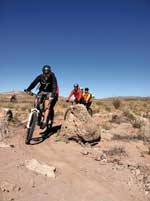 Rolly, twisty, and fast: that’s how our new Jurassic Trail looks and feels as it swoops along west of Copper Ridge Road in Little Valley in the Klondike Bluff Mountain Biking Area. This easy-to-intermediate roller coaster flows through the soft grays, pinks, lavenders, chocolate browns, and dusty turquoises of bulgy alluvial fans. On my recent mid-October hike, this desert palette contrasted with the bright yellow rabbit brush and sagebrush foliage in the washes to the east. Rolly, twisty, and fast: that’s how our new Jurassic Trail looks and feels as it swoops along west of Copper Ridge Road in Little Valley in the Klondike Bluff Mountain Biking Area. This easy-to-intermediate roller coaster flows through the soft grays, pinks, lavenders, chocolate browns, and dusty turquoises of bulgy alluvial fans. On my recent mid-October hike, this desert palette contrasted with the bright yellow rabbit brush and sagebrush foliage in the washes to the east.
The Jurassic Period occurred 199.6 to 145.5 million years ago, but the Jurassic Trail opened just two months ago in September. Located north of Arches National Park, Jurassic is south of other new Klondike trails, Alaska, Homer, Nome, and Inside Passage, all of which were built in 2013. Jurassic roughly parallels the Copper Ridge Road and its sister trail to the east, Dino-Flow.
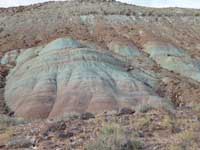 The Jurassic Period and this new trail are named for the Jura Mountains in the Alps on the border of France and Switzerland. The Juras were where limestone strata of this period were first studied in the late 1700s by German naturalist Alexander von Humboldt. The Jurassic was part of the 165-million-year Mesozoic (“middle life”) Era, when the supercontinent Pangaea split apart, and the northern half’s landmasses eventually formed North America and Eurasia. This rifting, along with warmer global temperatures, allowed for diversification and dominance of the dinosaurs. The Jurassic Period and this new trail are named for the Jura Mountains in the Alps on the border of France and Switzerland. The Juras were where limestone strata of this period were first studied in the late 1700s by German naturalist Alexander von Humboldt. The Jurassic was part of the 165-million-year Mesozoic (“middle life”) Era, when the supercontinent Pangaea split apart, and the northern half’s landmasses eventually formed North America and Eurasia. This rifting, along with warmer global temperatures, allowed for diversification and dominance of the dinosaurs.
The Jurassic Trail goes through the Brushy Basin Member of the Morrison Formation dominated by mudstone rich in volcanic ash containing fossilized bones of carnosaurs, stegosaurs, and long-necked sauropods; gastroliths (dinos’ digestive grinders); and shark’s teeth.
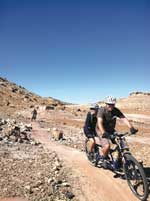 Last July, the days were hot and swampy from Moab’s monsoons, but reptiles were no longer the dominant fauna when the mammalian life forms of the Grand County Trail Mix crews started bench cutting, raking, rock lining, and constructing rock bridges. Last July, the days were hot and swampy from Moab’s monsoons, but reptiles were no longer the dominant fauna when the mammalian life forms of the Grand County Trail Mix crews started bench cutting, raking, rock lining, and constructing rock bridges.
The Jurassic Trail is about three miles of roughly even elevation throughout. A few sandy (and possibly muddy) wash crossings may require bikers to dismount and walk. Occasional narrow rock bridges, drain crossings, and twists and turns around refrigerator-sized boulders can challenge beginners. Hikers and bikers should wait for dry weather on the road, at the trailhead, and on the trail, as rains can gum up the ashy soil and clay.
North end trailhead: From Highway 191, turn east at mile marker 148.5 at the brown Northern Klondike Trails sign. Cross the railroad tracks, stay right, and follow the signs to N. Klondike. At mile 1.6 from 191, you’ll come to the southside post-and-cable parking lot for the Agate and Jasper loops. Jasper will connect to the north end of Jurassic. (Some bikers may prefer to ride back north to the car on the Dino-Flow Trail or the Copper Ridge Road.)
South end access: From Highway 191, turn east at mile marker 142.2 at the green “Klondike Bluff Road” and brown “Klondike Bluff Trails” signs and follow the carsonite “Klondike” signs. The Jurassic Trail starts off the Klondike Bluff Road. East of this trailhead is a view of the Marching Men formation in Arches.
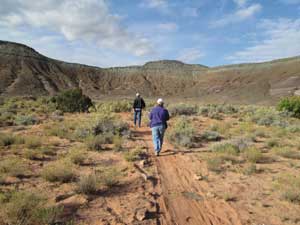 Moab is the southern tip of the 512-mile Dinosaur Diamond Prehistoric Highway that connects dinosaur and archaeology sites from Price to Vernal and east to Fruita, Colorado. Vertebrate resources are protected by the Paleontological Resources Preservation Act of 2009 and can be collected only by qualified researchers who obtain a permit and who agree to deposit the fossils in public institutions. Mustard-colored signs on trailhead kiosks remind users of the rules for protecting our fossils, including dinosaur trackways, such as the Copper Ridge Sauropod Trackway, the Mill Canyon Dinosaur Trail, and those at the Poison Spider Mesa parking area along Potash Road. Moab is the southern tip of the 512-mile Dinosaur Diamond Prehistoric Highway that connects dinosaur and archaeology sites from Price to Vernal and east to Fruita, Colorado. Vertebrate resources are protected by the Paleontological Resources Preservation Act of 2009 and can be collected only by qualified researchers who obtain a permit and who agree to deposit the fossils in public institutions. Mustard-colored signs on trailhead kiosks remind users of the rules for protecting our fossils, including dinosaur trackways, such as the Copper Ridge Sauropod Trackway, the Mill Canyon Dinosaur Trail, and those at the Poison Spider Mesa parking area along Potash Road.
For more information on Grand County ancient flora and fauna, visit the Moab Museum, catch a monthly meeting of Moab’s Gastonia Paleontology Club, or check out the Dinosaur Diamond kiosk on Highway 128. Whether you bike or hike on our newest trails in the Klondike, help protect our paleontological treasures, and stay on the trail and out of the mud.
Kathy Grossman has lived in Moab since 2011 and is the Grand County Trail Mix Committee Secretary and “Trail Happenings” Editor. She hikes, paints, writes, builds mountain bike trails, and has loved dinosaurs ever since seeing the T.Rex sequence in Disney’s 1940 movie Fantasia.
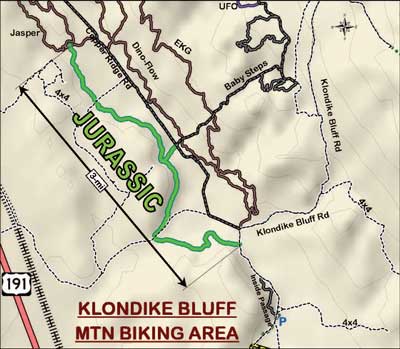
|
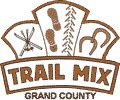 Trail Mix This committee represents non motorized trail users including: bikers, hikers, equestrians, and skiers. Many government agencies and private citizens comprise the “mix” that makes this group work so well. We meet the 2nd Tues. of each month from 12-2 at the Grand Center (500W. 182 N.). Everyone is welcome. Trail Mix This committee represents non motorized trail users including: bikers, hikers, equestrians, and skiers. Many government agencies and private citizens comprise the “mix” that makes this group work so well. We meet the 2nd Tues. of each month from 12-2 at the Grand Center (500W. 182 N.). Everyone is welcome.
Contact Sandy Freethey 259-0253 or find us online: wwwgrandcountyutah.net/trailmix/ or at moabtrailmixinfo@gmail.com.
|
|